Many people know the type of engine oil they use in their cars, but unfortunately the same can’t be said about brake fluid. We usually leave it to the mechanics. If you’re one of those individuals, it’s time to take matters into your own hands.
Just as there are different brands and qualities of engine oils, so are there various brake fluids. The type you use in your car will impact the performance of your brakes which ultimately determines your safety. So you can’t leave it to chance—especially if you expect to reach your intended destination without experiencing any brake failure.
To enlighten you with regards to the one to pick, we’ve come up with the 10 best brake fluids on the market. Plus, we’ve included detailed buyers guide to give you a better understanding of the product. It’s high time you know which brake fluid to use to ensure the optimal operation of your vehicle.
Features to Consider in Good Brake Fluids
We’ll start by discussing why this fluid is so important for your car.
Safety Reasons
The first and probably most important reason for using brake fluid is it ensures that your vehicle operates safely.
This is the liquid that allows your brakes to function as they should. It’s designed to apply pressure to your car rotors which in turn allows your car wheels to either slow down or stop completely.
Lubricate Your Car’s Moving Parts
Brake fluid works by lubricating your car’s moving parts while it’s in motion. As you’re probably aware, these parts are made of metal. And metal tends to corrode and rust over time if it’s not adequately lubricated.
Prevents Overheating
Each time you apply brakes, heat is generated around your braking system. Brake fluid is designed to neutralize this heating effect and therefore prevent the probability of your car engine from overheating.
Prevent Brake Failure
Brake fluid is a crucial component that ensures the brakes respond when necessary. The absence of brake fluid can lead to brake failure which may have devastating consequences.
Now let’s show you the products you should pick from for your car.
Top 10 Best Brake Fluids 2026
1. Castrol SRF Brake Fluid

Editor’s Rating:
Boiling Points
This brake fluid is formulated using exclusive European formula. It has a dry boiling point of 310ᵒC and a wet boiling point of 270ᵒC. As a result of these high boiling points, this fluid can withstand extreme temperature conditions.
Application
This Castro brake fluid is best used for high performance vehicles. If you own a race car then this is the product you.
Key Features
This product can be used by cars that need DOT 3 and DOT 4 brake fluid because it meets both specifications.
It features anti-vapor lock properties which encourages superior braking performance. This is because this functionality prevents gas from entering your braking system.
You’ll appreciate this smooth brake fluid which has no bubbles whatsoever. This product is available in cases of 12.
What we don’t like
As mentioned earlier, this product was specifically formulated for fast paced cars. This means you can’t use it on normal vehicles.
Also, note that it’s only sold by the litre so unfortunately you can’t get it if you want ½ litre bottles. Because it’s such a superior liquid, it’s not surprising that it’s not the cheapest brake fluid on the market.
Pros
- Superior quality
- High boiling points
- Allows for high braking performance
Cons
- Not for normal cars
- Pricy
- Sold by the litre
2. ATE Original Fluid

Editor’s Rating:
Boiling Points
This product has high boiling points; 536ᵒF dry and 374ᵒF wet boiling points. It’s clear how this fluid can withstand high operating temperature conditions.
Application
Much like the Castro brake fluid reviewed above, this product is ideally suited for high performance vehicles. But it can also be used in DOT 4 vehicles.
Key Features
This brake fluid falls under the DOT 4 classification which is evident by its high boiling points. One of the product’s invaluable features is that it contains water locking abilities.
Due to the porous nature of the braking system, water tends to seep through over time. This is why the manufacturer ensured that this fluid is designed to prevent water from penetrating into the braking system. This significantly reduces the chances of the brake fluid being diluted and losing its effectiveness.
As mentioned earlier, this product has a long life span. It can be changed after three years which makes it a cost effective product.
Not only does it offer superior braking performance but it prevents rusting and corrosion of your brakes. Plus, it’s designed to minimize the formation of steam bubbles which may compromise the performance of the fluid.
Because it’s a smooth non-foaming liquid, you’ll find it very easy to fill and drain.
The best part is for such phenomenal performance, it’s still one of the most affordable brake fluids on the market.
What we don’t like
Unfortunately, this fluid isn’t compatible with other types of brake fluids so avoid mixing it.
Pros
- Long life span
- Protects from corrosion and rusting
- Affordable
Cons
- Not compatible with other brake fluids
- Only works with DOT 4 vehicles
3. Bosch Brake Fluid

Editor’s Rating:
Boiling Points
This is one of the first products to combine low viscosity and a high wet boiling point of 365ᵒC.
Application
What you’ll appreciate about this product is that it can be used in almost all types of cars.
Key Features
This is an affordable but high quality brake fluid. We mentioned how compatible it is with other brake fluids. You can use it with DOT 3, DOT 4 and DOT 5,1 brake fluid. Here you can either use it together with these products or as a direct replacement.
This fluid has a low viscosity which is crucial for brake fluids because it won’t lose its effectiveness regardless of the operating temperatures.
Like the ATE brake fluid, this brake fluid also has a long life span. You can go for a couple of years before you need to change it—up to three years.
You’ll appreciate how this product is designed to lubricate the moving parts of your braking system during operation. Your brakes will not only perform better and quietly but also last longer.
What we don’t like
If you own a race car, this isn’t the product for you because it can’t be used in high performance vehicles.
Though it’s compatible with most brake fluids, it can’t be used with all of them. You can’t use it with DOT 5 brake fluid.
You need to practice extra caution around this product because it contains harmful substances so wear protective gloves when handling this product.
Pros
- Compatible with most brake fluids
- Used in most cars
- Inexpensive
- Long service intervals
Cons
- Not for race cars
4. Motul Racing Brake Fluid

Editor’s Rating:
Boiling Points
You’ll appreciate how this brake fluid has a higher wet and dry boiling point compared to other OEM products.
Application
As the name suggests, this fluid is best used in racing cars.
Key Features
This is a silicon based brake fluid which can guarantee effective braking performance. The product will work for you if you’re into frequent braking because it makes your brakes highly responsive.
This fluid falls under the DOT 4 class because of its high boiling points. This means that it can withstand operating in high temperatures. It’s less volatile compared to other brands. You’ll also appreciate how it encourages stable brake control.
You can expect superior aerodynamic performance if you use this product on your car.
What we don’t like
Unfortunately, this brake fluid has a shorter life span. You’ll need to change it more frequently compared to other types—at least twice a year.
Since it’s specifically designed for high performance vehicles, you can’t use in on your normal passenger vehicles.
Many people feel the price is rather high considering that it comes in a small container; it’s available in 500ml units. But considering the impressive specs it has, it may very well be worth every penny.
Pros
- High boiling point
- Not volatile
- Improves braking
Cons
- Pricy
- Small container
- Needs regular changing
5. Prestone Brake Fluid
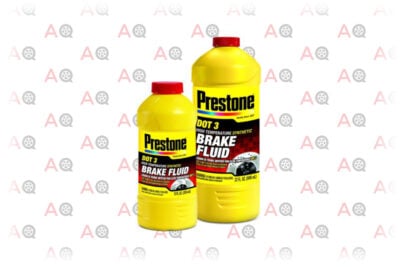
Editor’s Rating:
Boiling Points
This brake fluid has a dry boiling point of 238ᵒC and wet boiling point of 140ᵒC.
Application
As highlighted earlier, this product can be used in most cars. It’ll work best for your car’s ABS system, disc as well as drum brake systems.
Key Features
This brake fluid is formulated using a combination of polyglycol which allows the product to operate well in high temperatures. Using this fluid in such extreme temperatures won’t result in the creation of vapour which compromises the brake’s performance.
Your car’s braking system will be extremely responsive in emergency situations so take care of your safety concerns by using this brand.
This product falls under the DOT 3 class of brake fluid and has a lower boiling point compared to other types. It’s reasonably priced and is available in a sizeable 32oz bottle.
What we don’t like
This fluid won’t provide your vehicle with adequate protection against corrosion and rusting. Also, bear in mind that it contains chemicals.
Pros
- Big bottle
- High compatibility
- Doesn’t create dangerous vapor
Cons
- Causes rusting
- Harmful chemicals
6. Lucas Oil Brake Fluid
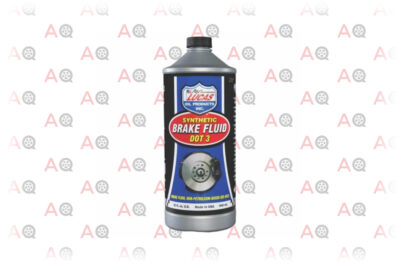
Editor’s Rating:
Boiling Points
This brake fluid has a minimum dry boiling point of 230ᵒC and 170ᵒF wet drying point.
Application
Because this product is compatible with most brake fluids it can be used in most cars. And it’ll work well for your vehicle’s disc, drum and clutch system.
Key Features
This is a high quality fluid that’s made using a combination of polyethylene glycol and other additives. The formula is designed to meet the industry safety standards.
The formula contains the right mix of substances to prevent the seal on your braking system from either hardening or softening—neither of which are desirable scenarios. It’s designed to lubricate the parts of your vehicle for optimum braking performance.
In addition, the fluid will protect your vehicle from rusting or corroding.
What we don’t like
Unfortunately, it can only be used with DOT 3 vehicles. It also contains substances that might cause health problems so practice extra caution when handling it.
Pros
- Prevents rusting and corrosion
- Lubricates braking system
- Affordable
Cons
- Not for high performance vehicles
- Some harmful ingredients
7. Castrol 12509 Brake Fluid

Editor’s Rating:
Boiling Points
This fluid has a dry boiling point of 310ᵒC and 270ᵒC.
Application
Because of the high boiling points, this brake fluid will work best in racing cars. Since the product is available in small bottles, it’ll work best as a topping fluid.
Key Features
Aside from the extremely low price, this brake fluid has a very high boiling point. As a result it falls under the DOT 4 classification. But it can still be mixed with other types of brake fluids such as the DOT 3.
This brake fluid will also protect the pipes in your car’s braking system from corroding and rusting.
Since it has a high boiling point, you can use it in high performance cars. By using this product, your car’s braking system will be highly responsive which is crucial for frequent braking.
You have the option to order a case of 12 bottles in the event that you want to perform an entire engine overhaul.
What we don’t like
The product is only available in small 12oz containers which is rather tiny.
Unfortunately this product isn’t recommended for use in ordinary vehicles. Like most brake fluids, it also contains harmful chemicals.
Pros
- Very cheap
- High boiling point
- Protects against corrosion
Cons
- Small containers
- Not for normal cars
8. Red Line Brake Fluid
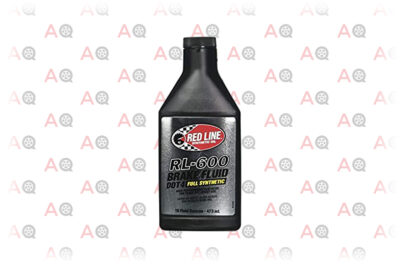
Editor’s Rating:
Boiling Points
The brake fluid has a high dry boiling point of 325ᵒC.
Application
If you’re looking for a multi-purpose brake fluid, this is the product to pick. Though it’s ideally suited for high performance vehicles you can use it on race cars, passenger vehicles as well as motorcycles.
Key Features
This is a synthetic blend of brake fluid which will work well for track use. Thanks to the high boiling points, it can withstand high operating temperatures. This means it won’t be losing its effectiveness, viscosity and stability regardless of extreme temperatures.
This fluid will also protect the moving parts in your car’s braking system from premature corrosion and rusting. In addition, it lubricates your vehicle during operation.
This product is not only resistant to water retention but also absorption. Moisture won’t be seeping into your car’s braking system to compromise its effectiveness.
The manufacturer formulated this fluid using high quality raw materials that are designed to minimize brake fade and vapour lock. Both situations will negatively impact the performance of your vehicle’s braking system.
You’ll appreciate how compatible this brake fluid is with other types such as DOT 3, DOT 4 and DOT 5,1.
What we don’t like
This product also contains harmful substances.
Pros
- Prevents corrosion
- Used for different types of vehicles
- Affordable
- Highly compatible
Cons
- Contains harmful substances
9. Pentosin Brake Fluid
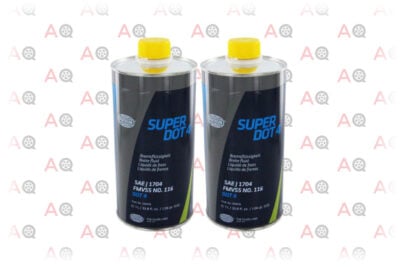
Editor’s Rating:
Boiling Points
This brake fluid has a high 265ᵒC boiling point.
Application
This Pentosin brake fluid will work best for your car’s ABS brake system.
Key Features
One of the product’s huge draw cards is that it contains extremely high corrosion resistance properties. By using this fluid, you’ll significantly protect your car’s system from premature rusting thereby prolonging its lifespan.
This fluid is designed to minimize water penetration thanks to the moisture resistant properties. Water won’t be infiltrating into your car’s braking system if you use this product. As a result this reduces the service intervals on your vehicle’s braking system. You don’t have to change the fluid frequently.
The properties present in this brake fluid makes it fall under the DOT 4 classification. Because it has a higher boiling point it’s ideal to use in high performance vehicles.
This fluid will protect your vehicle from the build up of dangerous vapour which can affect the performance of your car’s brakes.
What we don’t like
Unfortunately, it’s not very compatible with other brake fluids.
Also, if you stay outside of the US, you can’t access this product because it’s only shipped within.
Pros
- Corrosion resistant
- For high performance vehicles
- Prevents water absorption
- Affordable
Cons
- Doesn’t mix with other brake fluids
- Ships in US only
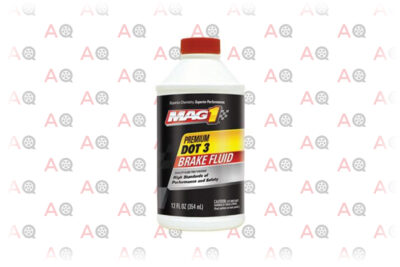
Editor’s Rating:
Boiling Points
This brake fluid has a dry boiling point of 256ᵒC and 145ᵒC wet boiling point.
Application
You’ll appreciate how versatile this brake fluid is especially if you have more than one vehicle. It can be used on different types of cars which makes it a cost-effective option.
Key Features
This brake fluid falls under the DOT 3 class. Note however that it has a relatively lower boiling point than most brake fluids stated on this list. As a result it can’t be used in high performance vehicles that operate in extreme temperatures.
The manufacturer packs this product in generous containers of 32oz which is a bargain considering the low price tag.
It’s not the best brake fluid on the market but it’ll certainly do the job. Your car’s brakes will perform as they should. Just be sure to adhere to the service intervals as stated by the manufacturer for optimum braking performance.
The formula in this brake fluid was formulated to meet the industry safety standards.
What we don’t like
You can’t use this brake fluid in racing cars. Also note that this product also can’t be shipped outside of the US.
Because it’s a synthetic fluid, it also contains chemicals that may be harmful.
Pros
- Affordable
- Meets safety requirements
- For everyday vehicles
Cons
- Only shipped in the US
- Harmful ingredients
Guide to Buying the Best Brake Fluids
Factors to Consider Before Purchasing Brake Fluid
Let’s face it; brake fluid pretty much looks the same no matter who you buy from, don’t you agree? But the reality is that there are certain features that you must look for before making your final purchase. These minute details affect how the product affects your car. In addition, these features will also affect the price of the product.
The most expensive product you come across is not always the best. This is why you need to know what features are really important so that you don’t spend more money than you have to.
What is the DOT Level ?
The DOT level is probably one of the first aspects you need to consider before buying your brake fluid. But note that the DOT level of the brake fluid you purchase isn’t really a matter of preference. Rather the manufacturer of your car usually states the DOT level your vehicle must use.
These are instructions which are clearly stated in the owner’s manual and which you must adhere to—no compromise.
Why? The DOT level of the brake fluid will determine the temperatures it can handle. Case in point; DOT3 has a lower boiling point than DOT4 and as such it should not be used in high temperature situations. We’ll discuss the different types a little later in the article.
How Big is the Product Container?
You need to pay attention to the size of the container. Is it big or small? It’s that simple. The reason for this is pretty obvious; you don’t want to spend a lot of money on a tiny container that’ll be empty in no time.
You do want value for your money, right? So, pay attention to the product size and know what you’re getting when you order. A 12oz bottle is pretty small and won’t contain much fluid.
Can it Resist Water Absorption?
Here’s the thing; the pipes and tubes that make up a braking system are porous in nature because they’re made of rubber. As a result, over time, it’s inevitable that water might penetrate into the system. This is an undesirable situation because the water dilutes the brake fluid thereby compromising performance of the product.
Water has a lower boiling point than brake fluid. And as such it’ll turn into steam pretty quickly. When this happens, the braking system unfortunately becomes less responsive and will perform below capacity.
Is it Non-Corrosive?
You want brake fluid that features non-corrosive properties. This is particularly true if you’re using the fluid on an older car which features seals made of rubber.
Also, spillages aren’t uncommon during brake maintenance such as when you’re topping up the system. When a corrosive liquid gets into contact with your car’s paintwork, the results are obviously undesirable. By using non-corrosive brake fluid, you significantly minimize any damage to your car’s paintwork in such cases.
What Color is it?
Not all brake fluids have the same color. Some manufacturers add a slight tint to their product. And no, this isn’t for cosmetic purposes. Rather it helps you differentiate the liquids when you’re draining the system.
The color of the fluid can either be amber, blue or pink.
Can it Maintain it’s Viscosity?
The brake fluid you pick should be able to maintain its viscosity regardless of the operating temperatures. Only then can the fluid give proper stability and traction control. Brake fluid that maintains its viscosity will ensure that your car’s anti braking system functions optimally.
Make sure you use a brake fluid which has viscosity levels as recommended by the car’s manufacturer.
What is the Boiling Point?
The boiling point of the brake fluid is extremely important as it affects performance of your brakes. Generally fluid with a high boiling point can be used in extreme temperature conditions that high performance cars operate in.
On the other hand, brake fluid with a low boiling point is ideally suited for everyday passenger vehicles.
The boiling point will affect the level of gas formation as the brakes are operating. Excessive gas formation can lead to brake failure if it’s not operating in the right temperature settings.
Is it Compatible With Other Brake Fluids?
Depending on the brake fluid you pick, it can either be compatible with other fluids or not. It’s important to pay attention to the manufacturer’s recommendations to avoid mixing the wrong brake fluids together. So, pay attention to the compatibility of the brake fluid you buy.
Also, brake fluids that are highly compatible with other brake fluids can be used in different vehicles.
Types of Brake Fluid
As mentioned earlier, brake fluid is classified according to DOT levels. There are four types of brake fluid as we’ll outline below.
DOT 3
This brake fluid is ideally suited for smaller cars that you use for “normal driving”. The liquid has a wet boiling point of 140ᵒC and dry boiling point of 205ᵒC. As a result it should not be used in high temperatures.
It’s designed to absorb approximately 2% moisture of its total volume in the space of a year. Bear in mind that it’s very strong and will more than likely damage your car’s paint.
Note that it mixes well with DOT 4 and 5,1 brake fluid.
DOT 4
This brake fluid has a higher boiling point of 155ᵒC and dry boiling point of 205ᵒC. As a result it’s ideal to use in higher temperatures making it the fluid to use if you own a larger vehicle.
Like DOT 3 brake fluid, it also absorbs moisture at 2% within a year. Plus, it mixes well with DOT 3 and 5,1 brake fluid types.
DOT 5
DOT 5 brake fluid is a synthetic blend which is silicon based. This brake fluid has a wet boiling point of 180ᵒC and dry boiling point of 260ᵒC. It’s ideally suited for use in high performance vehicles for example race cars.
Unfortunately, this brake fluid isn’t designed to absorb any moisture which can corrode the pipes in your braking system. Never mix this brake fluid with another type. Also, never use this type of brake fluid in vehicles that feature anti-lock brake systems.
Dot 5,1
Here is another brake fluid that can be used in high performance cars which feature ABS brake systems. It has a high dry boiling point of 180ᵒC and 260ᵒ C wet boiling point. Fortunately, this type has water absorption properties.
You can mix this brake fluid with DOT 3 and 4. However make sure that it doesn’t fall on your car’s paint because it’ll damage the look.
Good to Know
How Brake Fluid Works
You’ve seen the product reviews and you know the different types, but do you know how exactly brake fluid works?
Brake fluid is stored in the pipes of your car’s braking system. Each time you depress your brake pedal, the brake fluid is forced to move to the brake parts near the wheel. This action puts pressure on the wheel forcing it to stop or slow down.
In the absence of brake fluid, the above mentioned action is impossible and there is no way of stopping your vehicle. This is why it’s important that a certain amount of fluid always be in your reservoir at all times. And the only way to ensure this is if you conduct regular maintenance on your vehicle.
Why Brake Fluid Must Be Changed
Brake fluid must be changed regularly. And we strongly suggest that you hire a professional mechanic for the job. Why? Unlike the process of changing oil which is relatively straight forward, the same can’t be said about brake fluid.
Here’s why it’s tricky: upon opening the brake fluid reservoir, the ordinary person is less likely to notice any difference and assume that everything is okay. Maybe the color of the fluid looks the same or it appears to be at the right level. But the reality is that may not be the case.
Brake fluid tends to become less effective with time as the braking system absorbs water gradually. As mentioned earlier this significantly reduces the product’s effectiveness.
To be on the safe side, make sure that you take in your vehicle for service according to the instructions as stated in the owner’s manual. And it’s in your best interests to stick to the service intervals if you want your car to continue performing optimally.
Checking for Brake Fluid
It does pay to have an idea of how to check your brake fluid rather than leaving everything in the hands of the professional, so you’re prepared if you can’t reach a mechanic but need to check your car.
You’ll be happy to know that the process is relatively simple and straightforward as we’ll highlight below:
- The first step is to locate your car’s brake fluid reservoir. It’s usually located underneath the hood of your vehicle and it’s clearly marked.
- The next step is to carefully remove the lid of the reservoir.
- Check the level of brake fluid by using the markings on the side of the reservoir. These markings usually indicate the levels at which your brake fluid should be.
- In the event that it’s lower than the level it’s supposed to be, you have to add more fluid.
- Aside from checking the brake fluid’s level, you also need to inspect it for contaminants. The presence of contaminants will usually discolor the liquid.
- Note however that professional mechanics are more equipped to perform other tests to confirm the presence of harmful substances in the liquid.
Changing the Brake Fluid
In the event that you notice something out of the ordinary and the brake fluid needs to be changed, follow these steps:
- To get the job started you’ll need a turkey baster.
- Use this baster to try and get as much brake fluid out of the reservoir as possible.
- Then go ahead and add the new fluid. Make sure you fill up to the recommended level.
- Once you’re done, make sure you dispose of the old liquid properly. It’s not advisable to use old brake fluid in the name of cutting costs. You may end up doing more harm than good to your vehicle in the long run.
- The final step is to bleed the brakes. Only a professional can effectively do this particular task for optimum results.
Final Words
You’ve gone through the reviews and buying guide. Now it’s time to pick the right brake fluid for your car. It’s clear that the brand you pick will determine many factors including your brake performance and service intervals.
Opt for a product that’ll prolong your car’s braking system.
Regardless of the brand you pick, it’s crucial that you strictly adhere to the stipulated vehicle maintenance schedule. This is the only way to ensure that your vehicle’s braking system—and the overall car—continue to perform optimally. But more than anything else complying with the service intervals can save your life.
Do you know which product you’ll be picking for the next brake fluid changing process?


